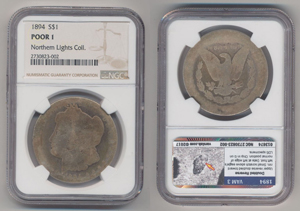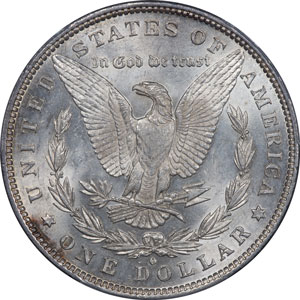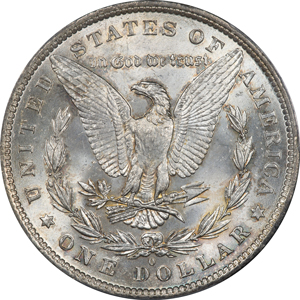
December 2017 - Welcome
Sources
Search
Contact
Home
Welcome
Click on year to expand
2022
2021
2020
2019
2018
2017
2016
2015
Welcome
Die Fingerprints
Collecting Lowball Morgans
This has been another busy month but much more with preparation for more coins to come.
![]()
![]() VSS Submission
VSS Submission
Our late October VSS submission is finally in and proved to be a little larger than anticipated. There are a total of 42 coins to add to our inventory, several of which are either VAM 5 or VAM 1D.
We also sent a number of coins for evaluation of conflicting information to see if there are duplicates we need to have LVA clarify.
![]()
![]() VAMs 10, 21, and 25
VAMs 10, 21, and 25
We reviewed all the coins we had for VAMs 10 and 25 (no one has a VAM 21) and concluded with the help of VSS that the reverse of the two VAMs are the same, although slightly different die states. On VAM 25 there some slight pitting around the bottom of the mint mark indicating a slightly later reverse die state than VAM 10. We will be sending in two examples to LVA for confirmation, and to discuss whether or not VAM 21 and VAM 25 are in fact the same and should be consolidated.
![]()
![]() New PCGS Grade Definitions
New PCGS Grade Definitions
In early November PCGS published a comprehensive set of definitions for each grade. While the substance changed just a little, the update was nice. The only surprise to us was the definition of MS64 and MS65 which we think is relaxed from earlier definitions.
DAWGS on TOP

Well the DAWGS did recover against Auburn and became this year's SEC Champions. So now it is own to the Rose Bowl to play Oklahoma on January first and work to make it in the finals.

GO DAWGS, SIC 'EM!!!
We continue to work on the die fingerprints, but as we get into the reverse dies it just raises more and more questions. So the slogging will be slow because the reverse dies seem to need more documentation and analysis for almost all VAMs.
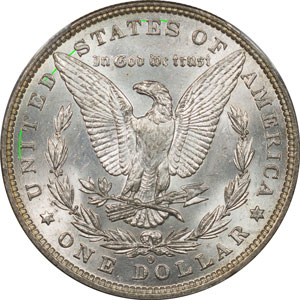
However, we did make it through Reverse Dies e, g, and o. The research on those three dies is shown below.
On Our Reading List
 If you enjoy a bit of history, romance, wanderlust, and adventure then Gold: Madness, Murder, and Mayhem in the Colorado Rockies by Ian Neligh might be a good book to pick up. The author covers a wide range of stories and experiences of mining in Colorado throughout history and carries the discussion into the current era.
If you enjoy a bit of history, romance, wanderlust, and adventure then Gold: Madness, Murder, and Mayhem in the Colorado Rockies by Ian Neligh might be a good book to pick up. The author covers a wide range of stories and experiences of mining in Colorado throughout history and carries the discussion into the current era.
The book is easily read and full of interesting stories about the characters that have been attracted to gold mining throughout the years.
![]()
And for this month that is it. We are having unseasonably warm weather and need to take time outside for painting and other activities. Usually by now we are into cooler, wetter weather here in Georgia. But this year warmer days are hanging around and we don't want to complain.
Pricing Update Due Soon
In July we published a recap of the pricing history of the 1881-O with some help from PCGS. The information is helpful in maintaining a proper perspective of the market, and we plan to update that page semi-annually.
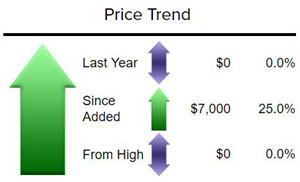
In December we will take another snapshot of the market pricing and publish it in January.
Michael Hoyman is recognized as one of the best, if not the best, lowball Morgan collectors of all time. He has repeatedly put together sets on PCGS that blow the competition away. His ability to get well-worn coins graded has become legendary and he has a Hall of Fame award from PCGS for his "End of the Trail" XI set, which has a perfect Poor 01 group with the exception of the 1893-S. The 1893-S may not exist in Poor 01, so his set is as close to perfect as possible.
Currently he has turned his attention to the creation of a lowball variety set, which will also be a timeless classic.
![]()
Lowball Morgans
Collecting lowball Morgan dollars can be and often times is very challenging. VAM graded coins are equally if not more challenging not because most collectors don't know what they're looking at or for. Its the graders and attribution department staff. Some are better than others while some are still trying to catch up in the field.
Every coin is a VAM of some sort or another. Finding VAM coins that can grade problem free is the collector's greater challenge. Looking for a certain VAM coin(s) can take months or years or just plain luck.
- For a lowball VAM coin finding the coin first and determining the grade is basically the first step in the process.
- Finding the PUPs is step two.
- Considering the coin's grade and if its useful is step three.
- Getting the coin to grade is step four.
One TPG may see things differently than another. If its a VAM issue try another TPG service and see what they have to say. My battles have never been about a coin's VAM marker or PUPs most of the time. Its been about the graders first and the attribution department second.
Having VAM experts come along side you is a "Rock" solid advice I would offer to you. "Hot Lips", Tailbar, Barwing, DDR, O/S mint marks, O/CC over mint mark, 7/8TF variety, and countless others are easy to spot if you know what to look for. Besides the basic coins those VAM markers are out there. Most aren't looking for them at first. The sharp eyes and knowledgeable sloths of the VAMworld will often spot what others miss.
Education about the coins you see can help to alleviate countless mistakes and either save or make you money. I have had several coins in at the graders many times with frustrating results. Either its a problem knowing what grade it is or VAM it is or lack of good coffee. In low ball grading of VAM coins especially a PO01 grade its important you know and understand what VAM it is with 100% confidence. After all its your money and knowledge being tapped.
Michael Hoyman
![]()
In other communications Michael notes that his biggest discovery may be an 1894-P, Poor 01, VAM 3.
"The 1894-P VAM-3 PO01 NGC graded Morgan dollar has to be the biggest accomplishment for both John Baumgart and myself. At PCGS five times. At ANACS twice and NGC three times. This happens to be the most counterfeited Morgan dollar surpassing the 1893-S dollar currently. Only the VAM-3 PUP can help authenticate the coin being genuine."
Click on the image to see a larger view
As you can tell from the NGC holder the coin originated with the Northern Lights Collection. The VSS label on the reverse validates the attribution.
Morgan Dollar "Fingerprints"
Morgan Dollar "Fingerprints"
Reverse Die g
Reverse Die o
In May 2017 we started an analysis of die cracks that we are likening to the uniqueness of fingerprints. We continue that analysis this month with the first of the reverse die analyses.
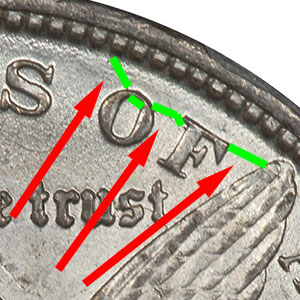
To observe the die cracks and breaks magnification is often needed. Also, high quality images such as the ones we use from VSS also help. Some die cracks are more visible in the high quality images because contrast is easier to create, which reveals the cracks. This analysis is really getting "down in the weeds," but that is a part of what makes this fun. Please remember that you are looking at later die states in most cases and coins of the same die/VAM combination will exist without many of these features.
Reverse Die e
Reverse Die e shows up with VAMs 7 and 45. The distinguishing characteristic is a mint mark that is set high.
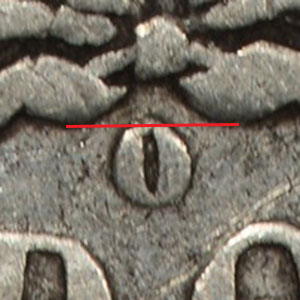
However, for us this is almost impossible to verify because these two VAMs are somewhat rare. We have a single example of VAM 7 and no examples of VAM 45.

32125850 Very Good 10
Because our only example is a Very Good 10 coin, it is difficult to verify if the mint mark is actually set high or has wear made it appear high? More examples from AU 55 or higher will be needed to verify the existence of this die and perhaps the existence of these two VAMs.
VAM 7 - O Set High is a pairing with Obverse Die 1. VAM 45 - Doubled Left 1, O Set High is a pairing with Obverse Die 30.
Our one example shows no signs of cracks or breaks, but at this low grade only the most severe cracks and breaks would show. More examples are needed for confirmation.
Reverse Die g is used on VAMs 9.1 and 46. The die is identified by what is designated as a "Dot in O."
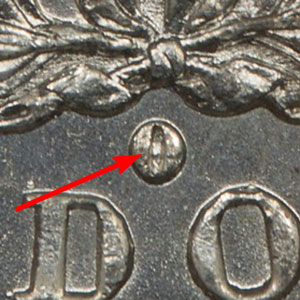
The dot actually appears to be a smooth area between other clutter within the mint mark.
VAM 9.1 - Doubled 18, Dot in O, is common and we have eighteen copies as of November 2017. Of those, fifteen are mint state and none show any signs of die cracks or breaks on the reverse.
83754655 Mint State 64
VAM 46 - Doubled 18, Dot O is less common than VAM 9, but in November of 2017 we had four examples for study, and three of those are mint state. VAMs 9.1 and 46 are differentiated only by tiny die chips below the 18 in the date near the denticles.
32142837 Mint State 62
None of the VAM 46 coins in our inventory show any signs of die cracks or breaks.
Reverse Die o makes an appearance with VAMs 36 and 38. It tis distinguished by the mint mark being set left and tilted slightly left. With VAM 38 the mint mark placement is the same, but there is also some accompanying doubling of leaves and letters in the Legend.
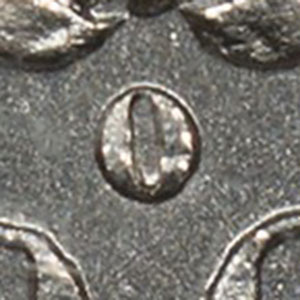
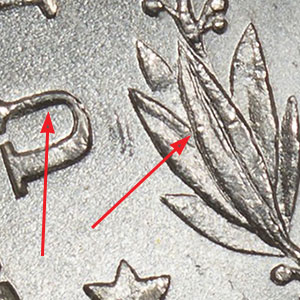
We have only one example of a VAM 36 - Doubled 8-1, O Set Left, Tilted Left, but it is a mint state coin. The coin shows no signs of die cracks or breaks. This VAM is formed with the marriage of Obverse Die 25 and Reverse Die o.
31858265 Mint State 63
The VAM 38 - Tripled Left Wreath, Double Legend, is a little different because we have five examples in our inventory. Five of the six are mint state coins and they range from Mint State 61 to Mint State 64. None of the coins show any signs of reverse die cracks or breaks. One of the coins is heavily toned, which can help reveal cracks, but this coin also shows no signs of cracks. VAM 38 is formed from a marriage of an obverse Die 1 with the Reverse Die o.
Getting Started
Collecting The 1881-O
The 1881-O VAMs





















